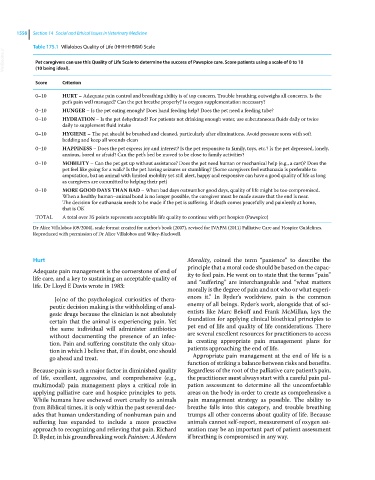Page 1620 - Clinical Small Animal Internal Medicine
P. 1620
1558 Section 14 Social and Ethical Issues in Veterinary Medicine
Table 175.1 Villalobos Quality of Life (HHHHHMM) Scale
VetBooks.ir Pet caregivers can use this Quality of Life Scale to determine the success of Pawspice care. Score patients using a scale of 0 to 10
(10 being ideal).
Score Criterion
0–10 HURT – Adequate pain control and breathing ability is of top concern. Trouble breathing outweighs all concerns. Is the
pet’s pain well managed? Can the pet breathe properly? Is oxygen supplementation necessary?
0–10 HUNGER – Is the pet eating enough? Does hand feeding help? Does the pet need a feeding tube?
0–10 HYDRATION – Is the pet dehydrated? For patients not drinking enough water, use subcutaneous fluids daily or twice
daily to supplement fluid intake
0–10 HYGIENE – The pet should be brushed and cleaned, particularly after eliminations. Avoid pressure sores with soft
bedding and keep all wounds clean
0–10 HAPPINESS – Does the pet express joy and interest? Is the pet responsive to family, toys, etc.? Is the pet depressed, lonely,
anxious, bored or afraid? Can the pet’s bed be moved to be close to family activities?
0–10 MOBILITY – Can the pet get up without assistance? Does the pet need human or mechanical help (e.g., a cart)? Does the
pet feel like going for a walk? Is the pet having seizures or stumbling? (Some caregivers feel euthanasia is preferable to
amputation, but an animal with limited mobility yet still alert, happy and responsive can have a good quality of life as long
as caregivers are committed to helping their pet)
0–10 MORE GOOD DAYS THAN BAD – When bad days outnumber good days, quality of life might be too compromised.
When a healthy human–animal bond is no longer possible, the caregiver must be made aware that the end is near.
The decision for euthanasia needs to be made if the pet is suffering. If death comes peacefully and painlessly at home,
that is OK
TOTAL A total over 35 points represents acceptable life quality to continue with pet hospice (Pawspice)
Dr Alice Villalobos (09/2004), scale format created for author’s book (2007), revised for IVAPM (2011) Palliative Care and Hospice Guidelines.
Reproduced with permission of Dr Alice Villalobos and Wiley‐Blackwell.
Hurt Morality, coined the term “panience” to describe the
principle that a moral code should be based on the capac-
Adequate pain management is the cornerstone of end of ity to feel pain. He went on to state that the terms “pain”
life care, and a key to sustaining an acceptable quality of and “suffering” are interchangeable and “what matters
life. Dr Lloyd E Davis wrote in 1983:
morally is the degree of pain and not who or what experi-
[o]ne of the psychological curiosities of thera- ences it.” In Ryder’s worldview, pain is the common
peutic decision making is the withholding of anal- enemy of all beings. Ryder’s work, alongside that of sci-
gesic drugs because the clinician is not absolutely entists like Marc Bekoff and Frank McMillan, lays the
certain that the animal is experiencing pain. Yet foundation for applying clinical bioethical principles to
the same individual will administer antibiotics pet end of life and quality of life considerations. There
without documenting the presence of an infec- are several excellent resources for practitioners to access
tion. Pain and suffering constitute the only situa- in creating appropriate pain management plans for
tion in which I believe that, if in doubt, one should patients approaching the end of life.
go ahead and treat. Appropriate pain management at the end of life is a
function of striking a balance between risks and benefits.
Because pain is such a major factor in diminished quality Regardless of the root of the palliative care patient’s pain,
of life, excellent, aggressive, and comprehensive (e.g., the practitioner must always start with a careful pain pal-
multimodal) pain management plays a critical role in pation assessment to determine all the uncomfortable
applying palliative care and hospice principles to pets. areas on the body in order to create as comprehensive a
While humans have eschewed overt cruelty to animals pain management strategy as possible. The ability to
from Biblical times, it is only within the past several dec- breathe falls into this category, and trouble breathing
ades that human understanding of nonhuman pain and trumps all other concerns about quality of life. Because
suffering has expanded to include a more proactive animals cannot self‐report, measurement of oxygen sat-
approach to recognizing and relieving that pain. Richard uration may be an important part of patient assessment
D. Ryder, in his groundbreaking work Painism: A Modern if breathing is compromised in any way.

